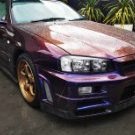Power Steering Rack Boot Oil Leak
Announcements
-
Similar Content
-
Latest Posts
-
Yes, I know🙄 but the sequential is not in my budget... don't want to reduce power neither, so looks like I'm stuck in the rabbit hole🤣
-
You’ll be very upset when you bust that too not to mention the gearing totally sucks. Don’t do it.
-
Is the panel filter one that is oiled? Have you ever cleaned or touched the AFM?
-
So.... the K&N air box thingo was too big, ended up gifting it to a mate, well, by gifting it he actually supplied food and beer at the pub, which was nice, as it will not sit on a shelf in the garage for the next 10 years I did trim up some of the existing stuff to neaten it all up and gave it some wrinkle paint, unfortunately it currently has a used and abused mish mash of different types of hose clamps, 4 big fat T bolt type (shit), and a few normal clamps of vairing sizes and brands, but..... only until the 6 constant tension black worm clamps that I ordered from EFI solutions turn up next week Currently the current hose clamps are triggering me hard, LOL Is this the final version, probably not, I really want just 2 silicone pieces, a straight bit of silicone from the filter to the MAF is easy and will happen as soon as I head into Just Jap tomorrow, the problematic part is a 30° silicone bend from the MAF to the TB that I can connect the engine breather from the head, I found that there are bulk head fittings for boat bilge pumps that should work, but until I can get a 30° silicone bend the alloy pipe, and the 11ty thousand hose clamps, are there for the foreseeable future 4 hose clamps are golden, 6 are grudgingly acceptable, the 8 currently holding it all together is just taking the piss I've also ordered 60 more retaining wall blocks for the front yard, I mis-gonculated the height that was required to get above the base of the Photinia's (red robin's) that are the hedge behind the front fence, currently it is 2 blocks high, and about 1/2 a block short, so going 3 blocks high will be above the base of the red robin's, and allow some room for mulch






Recommended Posts
Create an account or sign in to comment
You need to be a member in order to leave a comment
Create an account
Sign up for a new account in our community. It's easy!
Register a new accountSign in
Already have an account? Sign in here.
Sign In Now